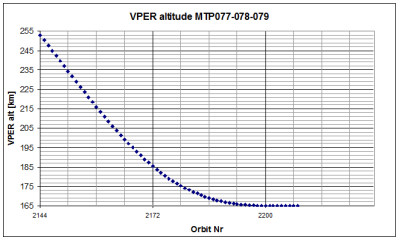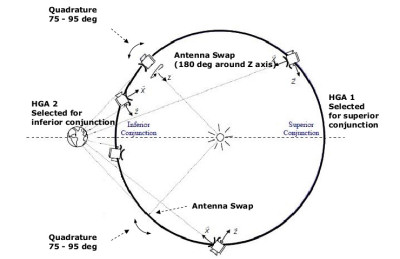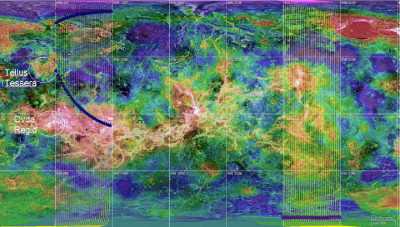No. 246 - End of quadrature and eclipse seasons, continuation of the mission's longest Earth occultation season and start of the eighth Atmospheric Drag Experiment campaign
Cebreros ground station
Operations with the Cebreros ground station for Earth communications were nominal during this reporting period. Short, nominal maintenance activities were carried out on 10 and 11 April. The average downlink data volume per orbit was 1556 Mbits.
Battery charge reconfiguration
During solar eclipse seasons, the spacecraft is in complete darkness during a portion of each orbit. At this time, the spacecraft bus and payload are powered by the on-board battery, which must then be recharged to 100% prior to the next eclipse. The battery (composed of three individual battery packs) is sized so that at the end of its life, the spacecraft can go through the longest eclipse and still retain enough stored power for the spacecraft to successfully complete a transition to 'safe mode' in the event of a spacecraft system anomaly.
When not in eclipse season, sufficient battery power must be maintained at all times for a transition to safe mode. However, relative to the eclipse period, a lower amount of energy (or end-of-charge state of 80%) is necessary in this case, as the extra energy needed for the eclipse period is not required. Lowering the battery's charge state prolongs its life.
The solar eclipse season ended after orbit 2180 (9 April 2012). On the following day, the battery charge state was lowered by 20%, to 24.4 V, where it will remain until the next eclipse season in June.
High accuracy spacecraft ranging
ESA's CEB and New Norcia (NNO) ground stations were used for a Delta Differential One-way Ranging (delta-DOR, or DDOR) measurement on 8 April.
For more information about DDOR, see the "Delta-DOR measurements" link in the right-hand column.
Eighth Atmospheric Drag Experiment campaign
The eighth Atmospheric Drag Experiment (ADE) campaign started on 25 April and continued until the end of this reporting period, on 28 April. During these campaigns, the spacecraft body and on-board gyroscopes are used as the instrument to provide data on the extreme upper atmosphere. By measuring its integrated effect on the spacecraft's attitude and position in orbit, the atmospheric density can be determined. During this campaign, the spacecraft's pericentre was allowed to decrease beyond its nominal altitude, down to 165 kilometres as the spacecraft flew over the northern pole of Venus. During closest approach, the spacecraft's solar panels are tilted to induce a very tiny roll in the spacecraft. This roll is countered by the reaction wheels, and the change in reaction wheel speeds can be used to determine the density of the atmosphere at this extreme upper altitude. The amount of drag experienced by the spacecraft is significantly lower than that which would be experienced during an aerobraking orbit change. The drag is maintained at this level, which is known to cause no problems for the spacecraft.
 |
|
Change in Venus Express pericentre altitude with time 4 March through 7 May 2012. Credit: ESA |
In this planning period, the low altitudes at pericenter (necessary for the drag measurements) coincided with a period of Earth occultations. To perform both the ADE and the radio science experiments simultaneously, the spacecraft was pointed at Earth during the ADE passes. (Further information about the science experiments is given in the section 'Scientific focus'.)
Orbit control manoeuvres
One nominal orbit control manoeuvre was carried out during this reporting period to raise the pericentre altitude after the ADE campaign observations were finished. It was performed smoothly at pericentre on 22 April.
Quadrature operations
The first five orbits during this reporting period, from 1 April through 5 April, took place while the spacecraft was in quadrature, which results in changes in antenna usage and restrictive thermal constraints being applied.
Each quadrature phase is defined as the period during which the Sun-Spacecraft-Earth angle is between 75 and 95 degrees. This occurs twice during each revolution of the Earth around the Sun: one is 'in-bound' quadrature - when Venus gets closer to Earth, and the other is 'out-bound' - when Venus recedes from Earth. The quadrature during this reporting period was 'in-bound'.
 |
|
Schematic diagram showing antenna selection during quadrature operation. Credit: ESA |
Two critical activities must take place during these phases, both of which are related to management of solar illumination on normally cold spacecraft faces:
- Biasing the spacecraft attitude when pointing towards Earth to avoid solar intrusion into the Venus Monitoring Camera's (VMC) field-of-view: The spacecraft attitude must be biased when pointing towards Earth for about two weeks before and after quadrature, when the Sun-Spacecraft-Earth angle is between 75 and 95 degrees. This avoids exposure of the VMC's sensitive components to the Sun, and continuously illuminates the +Y face (normally a cold spacecraft face) during Earth communications, at a 10 degree solar aspect angle (SAA). Hence, a special set of thermal constraints are defined by the spacecraft manufacturer, which results in significant limitations on routine science operations. Despite this, science activities continue (although they are somewhat reduced) through this phase. The ESA Flight Dynamics team at ESOC and Science Operations team at ESAC maintain dedicated interfaces during this period to handle the special thermal checks that are required.
- Antenna swaps to avoid illuminating thermally sensitive faces of the spacecraft: The Sun angle on the spacecraft during Earth communications periods determines which antenna must be used. When the spacecraft is at an Earth-Spacecraft-Sun angle of 90° and in in-bound quadrature, the -X face of the spacecraft would become illuminated during Earth communication. However, illumination of the -X face is forbidden during normal operations due to thermal constraints: all the spacecraft and thermal radiators used to cool the spacecraft are located on that face. Therefore, the antenna used during Earth communications is 'swapped' with the smaller antenna, HGA-2. The spacecraft is turned over to maintain the Sun only on the +Z and +X faces, positioning HGA-2 towards Earth. Earth communications is performed with HGA-2 during the entire period between the in-bound and out-bound quadrature, when Venus is closest to the Earth.
Summary of main activities
The table below shows a chronology of the main spacecraft bus activities in the reporting period:
| Main activities during reporting period | |||
|
MET = Mission elapsed time; DOY = Day of year; EOC = End of Charge; ADE = Atmospheric Drag Experiment; DOR = Differential One-way Ranging; NNO = New Norcia; CEB = Cebreros; OCM = Orbit Correction Manoeuvre; VeRA = Venus Radio Atmospheric Sounding |
|||
|
MET (Day) |
Date | DOY | Main Activity |
| 2336 | 01-Apr-2012 | 092 | CEB communication pass. NNO occultation pass. Change of telemetry bit rate to 45 kbps. |
| 2337 | 02-Apr-2012 | 093 | CEB communication pass. NNO occultation pass. |
| 2338 | 03-Apr-2012 | 094 | CEB communication pass. NNO occultation pass. |
| 2339 | 04-Apr-2012 | 095 | CEB communication pass |
| 2340 | 05-Apr-2012 | 096 | CEB communication pass. NNO occultation pass. |
| 2341 | 06-Apr-2012 | 097 | CEB communication pass. Removal of fake ephemeris before slew to Earth pointing attitude. |
| 2342 | 07-Apr-2012 | 098 | CEB communication pass |
| 2343 | 08-Apr-2012 | 099 | CEB communication pass. Short pass on request of Venus Express Science Operations Centre. Delta-DOR performed with CEB, NNO support. |
| 2344 | 09-Apr-2012 | 100 | CEB communication pass; NNO occultation pass |
| 2345 | 10-Apr-2012 | 101 | CEB communication pass. Short CEB maintenance from 07:00 - 12:00 UTC. Telemetry bit rate changed to 57 kbps. End-of-charge of batteries set to 24.4 V |
| 2346 | 11-Apr-2012 | 102 | CEB communication pass. Short CEB maintenance from 07:00 - 12:00 UTC. NNO occultation pass. |
| 2347 | 12-Apr-2012 | 103 | CEB communication pass |
| 2348 | 13-Apr-2012 | 104 | CEB communication pass. NNO occultation pass. |
| 2349 | 14-Apr-2012 | 105 | CEB communication pass. NNO occultation pass. |
| 2350 | 15-Apr-2012 | 106 | CEB communication pass. NNO occultation pass. |
| 2351 | 16-Apr-2012 | 107 | CEB communication pass |
| 2352 | 17-Apr-2012 | 108 | CEB communication pass. NNO occultation pass. |
| 2353 | 18-Apr-2012 | 109 | CEB communication pass |
| 2354 | 19-Apr-2012 | 110 | CEB communication pass. NNO occultation pass. |
| 2355 | 20-Apr-2012 | 111 | CEB communication pass |
| 2356 | 21-Apr-2012 | 112 | CEB communication pass. NNO occultation pass |
| 2357 | 22-Apr-2012 | 113 | CEB communication pass. |
| 2358 | 23-Apr-2012 | 114 | CEB communication pass. Downlink telemetry bit rate increased to 76 kbps. VeRA occultation observation via NNO. |
| 2359 | 24-Apr-2012 | 115 | CEB communication pass |
| 2360 | 25-Apr-2012 | 116 | CEB communication pass. VeRA occultation observation via NNO. ADE experiment. |
| 2361 | 26-Apr-2012 | 117 | CEB communication pass. ADE experiment. |
| 2362 | 27-Apr-2012 | 118 | CEB communication pass. VeRA occultation observation via NNO. ADE experiment. |
| 2363 | 28-Apr-2012 | 119 | CEB communication pass. ADE experiment via NNO. |
At the end of the reporting period on 28 April, Venus Express was 69 million kilometres from Earth. The one-way signal travel time was 230 seconds. The final oxidizer mass was 28.250 kg and the final fuel mass was 17.521 kg.
Scientific focus
This reporting period falls under medium term plan (MTP) # 78, 1 April through 28 April 2012.
The twentieth solar eclipse season ended on 7 April. During an eclipse season, Venus Express passes behind Venus (with respect to the Sun), so that the spacecraft travels through the shadow of the planet. This eclipse geometry provides unique viewing opportunities for the SOIR solar spectrometer: the spectrometer is trained on and tracks the Sun as it passes behind Venus and then reappears. The changes in the solar spectrum as it passes through the atmosphere of Venus can be analysed to determine the chemical composition and the temperatures at various altitudes of the Venusian atmosphere.
A long Earth occultation season (Venus Express's thirteenth) continued throughout this period. During occultation periods, as seen from the spacecraft, the Earth goes behind Venus and then re-emerges. This geometry can be exploited by the Venus Radio Science experiment (VeRa) to study the planet's atmosphere. As the Earth begins to move behind Venus, the spacecraft broadcasts a highly stable signal to Earth using its nominal high gain antenna for the period of operation. During this period, the large high gain antenna, HGA-1, was used. This signal passes through the Venusian atmosphere where it is refracted, and then received on Earth. The refracted signal can be studied to construct temperature profiles of the high- to mid-altitude Venus atmosphere. The aim is to carry out many such observations at various Venusian latitudes for maximum possible coverage of the planet.
Throughout this reporting period, in the ascending branch of the orbit when the spacecraft was pointed straight down at Venus, no thermally sensitive sides of the spacecraft were directly exposed to the Sun. Hence, this MTP was defined as 'cold'. During such 'cold' periods, the most common spacecraft pointings for science observations do not have thermal restrictions. The simpler observations can therefore be performed for longer periods of time and there is greater flexibility in scheduling all types of observations.
The local time at ascending node (LTAN) changed from 03:00 to 06:00 during this cold MTP. In addition to this cold configuration, the spacecraft was in the shadow of a solar eclipse for the first week of observations. During eclipses, the Venus Monitoring Camera (VMC) can be used to take images of the surface at an infrared frequency that escapes through the clouds in the atmosphere. The Ovda Regio and Tellus Tessera regions were targeted during this period.
 |
|
Venus Express coverage of Venus during 1-28 April, 2012. |
The geometry of the quadrature season puts Venus at maximum elongation from the Sun as seen from Earth - the planet is at its highest point in Earth's night sky. This means that ground-based observations of Venus are less affected by the turbulence of the Earth's atmosphere than when the planet is closer to the horizon. These quadrature periods are therefore of interest to ground-based observers of Venus, who may find it useful to compare their Earth-based data with that taken by Venus Express during the same period.
Payload activities
The instruments were operated nominally according to the plans of each instrument team.
| ASPERA | The instrument was operated nominally. |
| MAG | The instrument was operated nominally. |
| PFS | The instrument was not operated. |
| SPICAV | The instrument was operated nominally. |
| VMC | The instrument was operated nominally. A cloud-tracking campaign was carried out from 10 to 12 April 2012. The resulting image data will be analysed for waves in the clouds above surface features. |
| VeRa | The instrument was operated nominally for occultation observations. |
| VIRTIS | The instrument was operated nominally. |
Future milestones
- Continuation of the thirteenth Earth occultation season
- End of the eighth Atmospheric Drag Experiment
- Beginning of the twenty-first solar eclipse season
- Inferior conjunction in June
---
Legal disclaimer
This report is based on three ESOC mission operations reports, MOR #332 through MOR #335, as well as the MTP078 Master Science Plan. Please see the copyright section of the legal disclaimer (bottom of this page) for terms of use.

